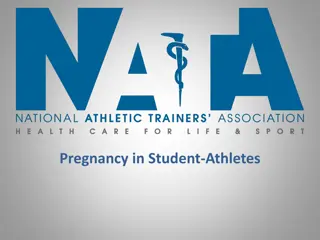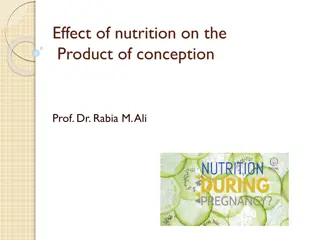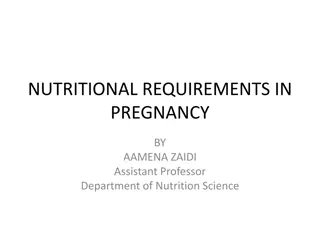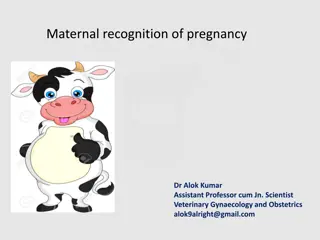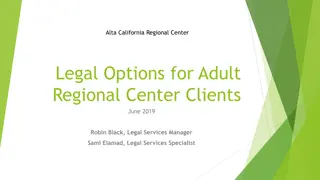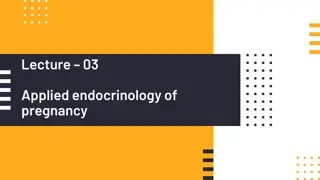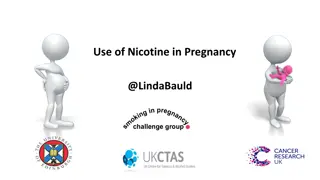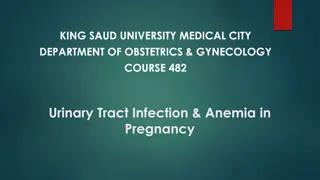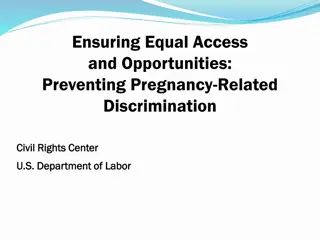Workplace Justice Summit - Protecting Pregnancy Rights in California
The Workplace Justice Summit, featuring Brenda Valle from the Department of Fair Employment and Housing, focused on legal protections for pregnant employees in California. The event highlighted key laws such as FEHA and CFRA, emphasizing the civil right to be free from discrimination due to pregnancy or related conditions. Employers were reminded of their obligations to provide reasonable accommodations and a discrimination-free workplace.
Download Presentation

Please find below an Image/Link to download the presentation.
The content on the website is provided AS IS for your information and personal use only. It may not be sold, licensed, or shared on other websites without obtaining consent from the author. Download presentation by click this link. If you encounter any issues during the download, it is possible that the publisher has removed the file from their server.
E N D
Presentation Transcript
Workplace Justice Summit September 7, 2016 Brenda Valle, Consultant III/Quality Assurance Specialist Department of Fair Employment and Housing www.dfeh.ca.gov contact.center@dfeh.ca.gov Communications Center (800) 884-1684 TTY (800) 700-2320
The California Department of Fair Employment and Housing Mission: to protect the people of California from employment, housing and public accommodations discrimination and hate violence. The DFEH enforces the California Fair Employment and Housing Act (FEHA), Unruh Civil Rights Act, Disabled Persons Act, and Ralph Civil Rights Act. 2
Educational Objectives Legal protections for pregnant employees and job applicants in California. Pregnancy disability leave (PDL) and return rights. California Family Rights Act (CFRA) baby bonding leave. Reasonable accommodations for pregnancy. 1. 2. 3. 4. 3
A Civil Right Freedom from discrimination because of pregnancy, childbirth, breastfeeding, a medical condition related to pregnancy, childbirth or breastfeeding, or the perception of pregnancy or related medical condition is a civil right. 4
Discrimination at Work It is unlawful for an employer to discriminate against a pregnant employee or job applicant in terms of compensation, and/or the conditions and privileges of employment. 5
Statutory Protections The Fair Employment and Housing Act (FEHA) and the California Family Rights Act (CFRA) provide protections and guarantees for pregnant employees and job applicants. 6
Employer Requirements The FEHA covers all California employers with 5 or more full or part time employees. The CFRA applies for California employers with 50 or more full or part time employees within 75 miles of the employee s worksite. 7
Protections for Job Applicants It is unlawful for an employer to ask a job applicant questions regarding childbearing, pregnancy, birth control or familial responsibilities unless they are related to specific and relevant working conditions of the job in question. 8
PDL: Eligibility PDL is for the period of actual disability caused by pregnancy, childbirth, or related medical conditions. (Gov. Code, 12945, subd. (a).) A woman is disabled by pregnancy if, in the opinion of her health care provider, she is unable because of pregnancy to work at all, or is unable to perform any one or more of the essential functions of her job or to perform these functions without undue risk to herself, the successful completion of her pregnancy, or to other persons. (Cal. Code Regs., tit. 2, 11035, subd. (f).) There is no length of service requirement before an employee disabled by pregnancy is entitled to PDL. (Cal. Code Regs., tit. 2, 11037) 9
PDL Before and After Birth PDL can be taken before or after birth during any period of time the woman is physically unable to work because of pregnancy or a pregnancy-related condition. This includes time off for prenatal care, severe morning sickness, doctor-ordered bed rest, childbirth, recovery from childbirth, or any related medical condition. 10
PDL: Length of Leave An employee disabled by pregnancy is entitled to up to 4 months disability leave per pregnancy. Four months means the number of days the employee would normally work within four months. If an employer has a more generous leave policy for other temporary disabilities than is required under FEHA (i.e. more than 4 months), the employer must provide such leave to employees temporarily disabled by pregnancy. 11
PDL: Length of Leave PDL does not need to be taken in one continuous period of time. PDL may be taken intermittently on an as-needed basis or on a reduced work schedule. All leave taken in connection with a specific pregnancy counts toward computing the four month period. 12
PDL: Length of Leave Length of PDL may be modified as a woman s changing medical condition dictates. If a woman desires to return earlier than agreed, an employer must reinstate her within two business days of her notice to the same position. 13
Hypothetical #1 A full-time pregnant employee, Betty, missed 2 hours of work in the morning because of severe morning sickness. Betty reports to work and works the remaining 6 hours of her regularly assigned shift. How many hours can the employer charge against Betty s pregnancy disability leave entitlement? 14
Hypothetical #1 A) 8 hours B) 2 hours C) 6 hours D) 0 hours 15
PDL: Notice to Employer If possible, an employee must provide her employer with at least 30 days advance notice of the date for which the pregnancy disability leave is sought and the estimated duration of the leave. Notice should be given for planned medical appointments and of the expected date of birth. Verbal notice may be sufficient if it makes the employer aware that the employee needs PDL, and of the anticipated timing and duration of the PDL. 16
PDL: Certification of Disability The employer may require the employee to obtain a certification from her health care provider of her pregnancy disability leave. The employer may require the certification include: (1) date on which the employee become disabled due to pregnancy; (2) the probable duration of the period or periods of disability; and, (3) a statement that, due to the disability, the employee is unable to work at all or is unable to perform any one or more of the essential functions of her position without undue risk to herself, the successful completion of her pregnancy, or to other persons. 17
PDL: Pay/Benefits PDL is unpaid time off. Employer may not require employee to use vacation time, but may require employee to use accrued sick leave. Employee may chose to use accrued vacation, sick leave, or any other accrued time off. Generally, an employer must provide the same benefits, pay, medical insurance to employees on PDL as is provided to all other employees who take temporary disability leave. Employer must maintain and pay for group health coverage for an employee who takes pregnancy disability leave for the duration of the leave, not to exceed four months. 18
PDL: Return Rights After a pregnancy disability leave or transfer, employees are guaranteed a return to the same position and can request the guarantee in writing. If her same position is no longer available, such as in a layoff due to plant closure, the employer must offer a position that is comparable in terms of pay, location, job content, and promotional opportunities, unless the employer can prove that no comparable position exists. 19
Hypothetical #2 Employee Abby is returning back to work from PDL. Can her employer Acme Widgets require Abby to undergo a physical to re-qualify her for her former position? Yes No A) B) 20
Hypothetical 2B Can Acme Widgets put Abby back on probation for 6 months following her return to work from PDL? Yes No A) B) 21
PDL: Medical Release to RTW If the employer has uniformly required releases from all employees returning from non-pregnancy related disability leave, the employer can require the employee to obtain and submit a return to work release from her health care provider stating that she is able to resume her same duties. 22
PDL: Employer Defenses Employee would have lost her original position because of legitimate business reasons unrelated to her pregnancy, even if she had not taken PDL and no comparable position is available (e.g., layoff). Preserving the original or a comparable position would substantially undermine the employer s ability to operate the business safely and efficiently. The employer bears the burden of proof. 23
CFRA: Baby Bonding Leave Eligibility Employee must have more than 12 months of service. Employee have worked at least 1,250 hours in the 12 month period before the date the requested leave begins. The employer must employ more than 50 employees within a 75 miles of the worksite where the employee works. An employee is anyone on listed on the employer s payroll for 20 or more weeks of the current or preceding year, even if on leave. 24
CFRA: Length of Leave CFRA leave may be up to 12 work weeks in a 12 month period for the birth of a child, or placement of an adopted or foster care child. CFRA baby bonding leave generally must be taken for a minimum of two weeks. Leave may be taken on an intermittent basis if medically advisable. CFRA leave must be concluded within one year of the birth/placement of the employee s child. 25
CFRA: Length of Leave If an employee is CFRA-eligible, she may take both PDL and CFRA leave for reason of birth of her child. For example, an employee could take four months PDL for her disability during pregnancy, and then take 12 weeks CFRA leave to bond with her baby. If an employee exhausts her four months of PDL before the birth of her child, she and her employer can agree to let her start CFRA leave early. 26
CFRA: Notice to Employer The employer may require 30 days advance notice if the need for the leave is foreseeable. If not foreseeable, then notice must be given as soon as practicable. Employee must state a CFRA qualifying reason for the leave, but need not mention CFRA. The birth of a baby or placement of an adopted or foster child is a CFRA qualifying event. 27
CFRA: Pay/Benefits Leave is unpaid. Employer must maintain health insurance benefits. Leave not considered break in service for seniority or retirement purposes. Employer may require employee to use accrued vacation. Employee may elect to use accrued vacation and sick time. 28
Hypothetical #3 Mary had a difficult pregnancy and was on PDL for 4 months prior to the birth of her son. Her doctor released her to return to work but she would like to remain on leave to bond with her son. Her son does not have any serious conditions. Can Mary remain on leave? Yes No A) B) 29
Hypothetical #3B If Mary can stay out on bonding leave through CFRA, how long can she stay out? 4 months 8 work weeks 12 work weeks D) 0 she must return to work A) B) C) 30
Hypothetical #4 Mark wants to take bonding leave for placement of a foster daughter in his home. Does Mark have to take 12 weeks of bonding leave all at once? Yes No A) B) 31
CFRA: Right to Return The employer may require employees returning from CFRA leave to provide a medical certification that they are able to return to work ONLY IF the employer has a uniform practice or policy of requiring such releases from other employees returning to work following illness, injury, or a period of disability. Employee must be reinstated to the same or comparable position upon returning from leave. Employment in a position that has the same or similar duties and pay that can be performed at the same or similar geographic location as the position held prior to leave. (Gov. Code, 12945.2, subd. (c)(4).) 32
CFRA: Employer Defense The employee would not have been employed at the time of the leave period. E.g., layoff during CFRA qualifying leave. The employer bears the burden of showing by a preponderance of the evidence that the employee would not otherwise have been employed by the employer at the time reinstatement is requested. 33
CFRA: Employer Defense An employer may refuse to reinstate an employee returning from leave if all of the following apply: The employee is salaried and among the highest paid 10% of all employees within 75 miles of employee s work site; Refusal to reinstate is necessary to prevent substantial and grievous economic injury to the employer s operations; and The employer notifies the employee in writing of its intent not to reinstate as soon as the employer determines that refusal to reinstate is necessary. 34
Reasonable Accommodation In addition to guaranteed leave for pregnant employees, the FEHA requires covered employers to reasonably accommodate an employee s pregnancy and related medical conditions to the same extent as it would accommodate other disabilities. 35
Reasonable Accommodation As with other requests for reasonable accommodation, the employer is required to explore with the employee all possible means of reasonably accommodating her pregnancy related disability prior to making any employment related decision. an accommodation is reasonable if it does not impose an undue hardship on the employer s business. 36
RA: Examples of Accommodation Reasonable accommodation can include, but is not limited to, changing job duties or work hours, providing leave, relocating the work area, and/or providing mechanical or electrical aids. 37
RA: Transfer as Accommodation As an accommodation, and with the advice of her physician, an employee can request transfer to a less strenuous or hazardous position for the duration of her pregnancy. 38
RA: Certification An employer may require the employee to obtain a certification from her health care provider of the medical advisability for a reasonable accommodation. Certification should only be required to the same extent that certification is required in support of other requests for reasonable accommodation from non-pregnant employees. The employer may require the certification include: (1) the date the reasonable accommodation became medically advisable; (2) the probable duration of the period or periods of the reasonable accommodation; and, (3) an explanatory statement that, due to the woman's pregnancy, the reasonable accommodation is medically advisable. 39
RA: Employer Response The employer must respond to the request as soon as practicable, but in no event, later than 10 calendar days after receiving the request. 40
RA: Employer Defenses An employee s request for accommodation need not be honored if: (1) the request would require the employer to create additional employment that the employer would not otherwise have created; (2) the request would require the employer to discharge any employee, transfer an employee with more seniority, promote an employee not qualified to perform the job or violate any CBA. 41
RA: Posting of Rights Employers must give employees reasonable advance notice of their FEHA rights and obligations regarding pregnancy, childbirth, related medical conditions, or pregnancy disability leave. Employers must post the notice in a conspicuous place where employees can see it. Employers must give an employee a copy of the notice as soon as the employee tells the employer of her pregnancy or sooner if the employee inquires about reasonable accommodation or leave. 42
www.dfeh.ca.gov contact.center@dfeh.ca.gov Communication Center (800) 884-1684 TTY (800) 700-2320 43



